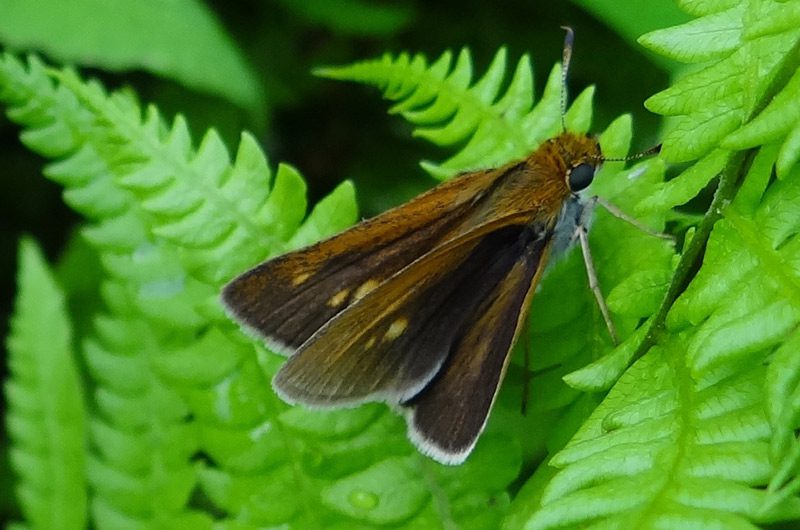LandPKS Learning
Habitat Hub

Two-spotted skipper
While worldwide the two-spotted skipper is secure, that is not necessarily the case on a local basis. Most states where the butterfly resides consider it fairly rare
Euphyes bimacula
Identification
The two-spotted skipper is a small orange and brown butterfly with pointed forewings with white fringe. They have a white underbelly and under the head, while the top of the body is dark brown. The male’s forewing has a yellow-orange patch, and the female’s forewing has two pale yellow-orange spots. The two-spotted skipper has a wingspan of 1.26-1.65 in/3.2-4.2 cm. This butterfly has a distinct white line on the hindwing parallel to the body. The larvae or caterpillars are pale green with dark markings on their yellow head and a dark dorsal stripe. The caterpillars eat leaves and live in nests of rolled leaves.
Observation Tips
The two-spotted skipper has a wide range throughout North America and can be found from New England and Ontario to the Carolinas, and west to Wisconsin, Iowa, and Nebraska, while considered rare in adjacent states such as Colorado. The skipper usually emerges around late June into mid-July. Males can be found perching within 3 ft/0.9 m of the ground in sedge marshes to watch for females.
Interesting Fact
While worldwide the two-spotted skipper is secure, that is not necessarily the case on a local basis. Most states where the butterfly resides consider it fairly rare
Ideal Habitat
The two-spotted skipper often prefers moist environments and wetlands such as marshes, bogs, wet streamsides, and wet sedge meadows. They are found in open, sunny savannas with relatively short (<12 in/30 cm tall) vegetation and prefers the wettest part of pine savannas. The two-spotted skipper feeds on the nectar of flowers, especially pickerelweed, sweet pepperbush, blue flag iris, common milkweed, and spiraea, and hairy-fruit sedge. Hairy-fruit sedge is the main food source for caterpillars and the host plant where the skipper lays their eggs. This plant is not found in the western part of the butterfly’s range, so it is unknown what sedge species the caterpillar feeds on in Nebraska and Colorado.

Range map provided by NatureServe
Management Activities that Benefit Species – Best Management Practices (BMPs)
Maintain intact marshes and wetlands to provide habitat for the two-spotted skipper nectar plants. When practicing weed management, minimize herbicide use near wetlands and other natural areas. Since skipper host plants are known, consider these native plants and host species to increase available habitat when restoring or replanting wetland areas. Overall, keeping wetlands dominated by native species and clear of aggressive invasive species will likely support skipper populations.
Management Activities to Avoid
Avoid draining and ditching wetlands and marshes. Avoid using pesticides near wetlands and riparian areas.
Other Species that Benefit from Similar Habitat Management
Management for the two-spotted skipper will also benefit many other species of prairie butterflies and skipper species as well as other wetland species.
Download
Download the Two-spotted skipper fact sheet
Other Resources
Butterflies and Moths of North America. 2021. Two Sotted Skipper Euphyes bimacula
eButterfly. 2018. Larrivee M, Prudic KL, McFarland KP and J Kerr. eButterfly: a citizen-based butterfly database in the biological sciences. Two-spotted Skipper
Wilcox, Ted. 2006. Butterflies of North Carolina: their Distribution and Abundance. Two-spotted skipper.
Virginia Department of Conservation and Recreation. 2021. Atlas of Rare Butterflies, Skippers, Moths & Dragonflies of Virginia. Euphyes bimacula
Heiser, Emily. 2011. New Jersey Threatened and Endangered Field Guide. Conserve Wildlife Foundation of New Jersey. Two-spotted skipper
Ries, L. Debkinski, D. M. and Wieland, M. L. 2002. Conservation Value of Roadside Prairie Restoration to Butterfly Communities. Society for Conservation Biology.
Photo credit: Pete Woods/iNaturalist
Mobile App | Data Portal | Knowledge Hub | Habitat Hub | Learning Collections | Blog | About | Contact | Support



